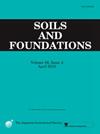主应力轴旋转作用下珊瑚砂颗粒破碎特性及模型
IF 3.3
2区 工程技术
Q2 ENGINEERING, GEOLOGICAL
引用次数: 0
摘要
为研究主应力轴旋转作用下珊瑚砂的应力-应变特性及颗粒破碎规律,对不同固结围压和压实度的珊瑚砂进行了三轴试验和主应力轴旋转试验。在此基础上,建立了考虑珊瑚砂内部不规则性和非均匀性的颗粒破碎模型。结果表明:(1)扫描电镜(SEM)分析和三轴试验表明,珊瑚砂具有较强的非同轴特性。压实度和围压的增加均可提高珊瑚砂的强度;(2)珊瑚砂在三轴剪切过程中经历剪切膨胀后逐渐压缩,在密实度较高时表现为体收缩。珊瑚砂破碎颗粒以大颗粒为主,小颗粒较少破碎或未破碎,棱柱消失是颗粒破碎的主要类型;(3)在主应力轴旋转作用下,珊瑚砂颗粒破碎形式主要为磨粒破碎。珊瑚砂的不规则性和非均匀性可以用主应力轴旋转变形破坏过程中的非同轴性等效来表示,并建立了表征珊瑚砂颗粒破坏行为的数学模型。令人印象深刻的是,该模型在预测主应力旋转下的颗粒破碎方面显示出很高的准确性(平均误差<;5%)。本文章由计算机程序翻译,如有差异,请以英文原文为准。
Characteristics and modelling of coral sand particle breakage under principal stress axis rotation
To investigate the stress–strain characteristics and particle breakage laws of coral sand under the rotation of the principal stress axis—Objectives, the triaxial test and the principal stress axis rotation test were conducted on coral sand with varying consolidation confining pressures and compactness—Methods. Furthermore, a particle breakage model considering the irregularity and non-uniformity inherent in coral sand was established. The results show that: (1) Scanning electron microscopy (SEM) analysis and triaxial test demonstrates that the coral sand has strong non-coaxial characteristics. Both increased compactness and confining pressure enhance the strength of coral sand; (2) Coral sand undergoes shear expansion followed by gradual compression in triaxial shear, and demonstrates body shrinkage when its compactness is relatively high. The broken particles of coral sand are mainly large particles, small particles are less broken or not broken, and the disappearance of prism is the main type of particle breakage; (3) The form of particle breakage in coral sand under rotation of the principal stress axis is mainly grinding—Key Findings. The irregularity and non-uniformity of coral sand can be represented with the equivalent of non-coaxiality in the deformation and breakage process of the principal stress axis rotation, and a mathematical model has been established to characterize the breakage behavior of coral sand particles. Impressively, The model demonstrates high accuracy in predicting particle breakage under principal stress rotation (average error < 5 %).
求助全文
通过发布文献求助,成功后即可免费获取论文全文。
去求助
来源期刊

Soils and Foundations
工程技术-地球科学综合
CiteScore
6.40
自引率
8.10%
发文量
99
审稿时长
5 months
期刊介绍:
Soils and Foundations is one of the leading journals in the field of soil mechanics and geotechnical engineering. It is the official journal of the Japanese Geotechnical Society (JGS)., The journal publishes a variety of original research paper, technical reports, technical notes, as well as the state-of-the-art reports upon invitation by the Editor, in the fields of soil and rock mechanics, geotechnical engineering, and environmental geotechnics. Since the publication of Volume 1, No.1 issue in June 1960, Soils and Foundations will celebrate the 60th anniversary in the year of 2020.
Soils and Foundations welcomes theoretical as well as practical work associated with the aforementioned field(s). Case studies that describe the original and interdisciplinary work applicable to geotechnical engineering are particularly encouraged. Discussions to each of the published articles are also welcomed in order to provide an avenue in which opinions of peers may be fed back or exchanged. In providing latest expertise on a specific topic, one issue out of six per year on average was allocated to include selected papers from the International Symposia which were held in Japan as well as overseas.
 求助内容:
求助内容: 应助结果提醒方式:
应助结果提醒方式:


